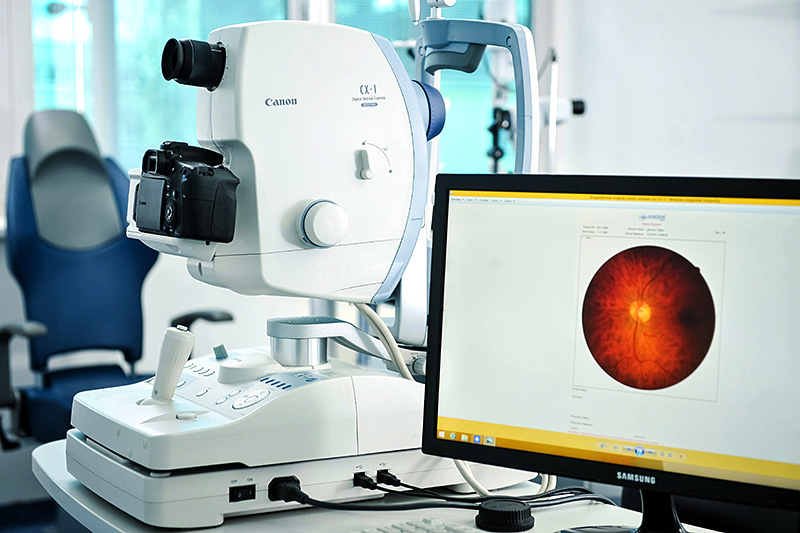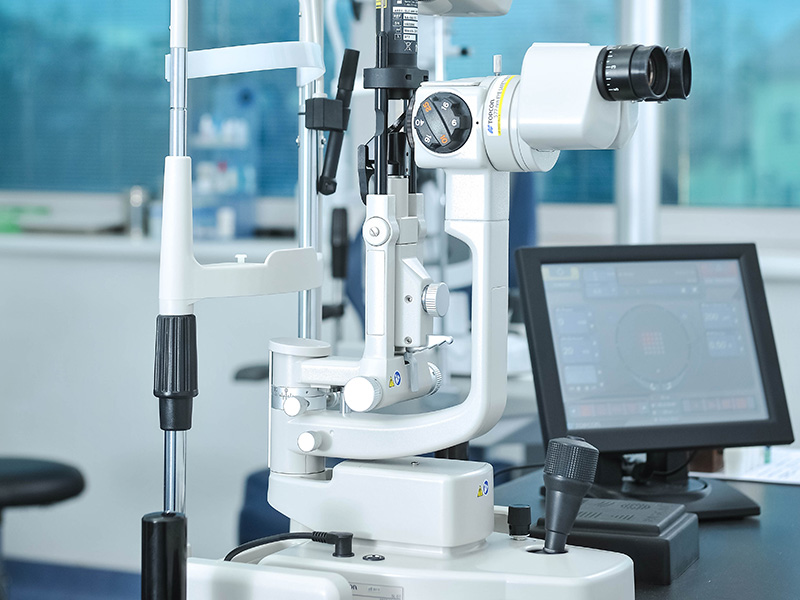
Ask For More Information
- E-mail: info@svjetlost-sarajevo.ba
- Phone: +387 33 762 772
- Dr. Mustafe Pintola 23
- 71000 Sarajevo- Ilidža
Special Hospital for Ophthalmology Svjetlost Sarajevo - Branch 1
- E-mail: klinika@svjetlost-sarajevo.ba
- Phone: +387 33 821 919
- Bolnička 8A
- 71000 Sarajevo
Diabetic retinopathy
Diabetes and the eye
Diabetes is the leading cause of blindness and poor vision of the working population in the world. The eye is, unfortunately, very often damaged due to diabetes whereby no part of the eye is spared. Eyes of the people suffering from diabetes is more prone to the occurrence of various infections and degenerative processes, and the cataract also occurs early. The most important complication of diabetes on the eye is diabetic retinopathy.
What is diabetic retinopathy?
It is a complication of diabetes in which there is damage to the inner layer of the eye, which is made up of nerve cells, and is called the retina. The retina has a key role when it comes to the human vision because the light that enters the eye through the nerves of the retina is converted into an electrical impulse that travels to the brain through the optic nerve, which provides us with vision. Diabetes is microangiopathy, i.e. small vessel disease, and therefore the retina is particularly affected due to ts very small blood vessels.

What are the symptoms of diabetic retinopathy?
Impaired vision is the main sign of diabetic retinopathy. Impaired vision occurs for two reasons. The first is when the blood vessels in the center of the eye become permeable due to elevated blood sugar levels so there is edema or swelling in the center of the eye (yellow spot). This condition is called diabetic macular edema. The liquid that came out of the blood vessels damages the nerve cells that degenerate, leading to the weakening of central vision.
Another way in which diabetes weakens eyesight is when long-term diabetes leads to the blockage of blood vessels of the eye. In this case, the response of the eye to ischemia (malnutrition) is the development of neovascularization or degenerative blood vessels. This stage of diabetic retinopathy is called proliferative diabetic retinopathy. Newly formed blood vessels have a very unstable wall that often ruptures causing the bleeding in the eye or hemophtalmos. A person notices this as a rapid deterioration of vision or it feels like a fog has been lifted in front of the eye. If the condition is not treated, the connective tissue next to the vessels becomes enlarged and detaches the retina due to its contractile properties. This is a very dangerous condition and it is very challenging to treat.
What is the treatment for diabetic retinopathy?
 Initially, the main treatment was laser treatment wherein we coagulated permeable blood vessels of the retina. Today, the standard treatment of macular edema and diabetic retinopathy are intravitreal injections of drugs from the anti-VEGF group of drugs. The injections are given after a local anesthesia by administering drops through the sclera and are completely painless. The treatment is carried out monthly over several months or years. With the help of these injections better results are achieved than after laser treatment because the laser damages the surrounding healthy tissue. The result is often vision improvement, not merely the stabilization of the existing vision. After improving the vision by injections, the treatment is supplemented by conventional laser treatment, which then permanently preserves the status quo. At our clinic, we have the most modern laser fotokoagulator Pascal, which is significantly less painful, and the process is several times shorter and is implemented in fewer sessions.
Initially, the main treatment was laser treatment wherein we coagulated permeable blood vessels of the retina. Today, the standard treatment of macular edema and diabetic retinopathy are intravitreal injections of drugs from the anti-VEGF group of drugs. The injections are given after a local anesthesia by administering drops through the sclera and are completely painless. The treatment is carried out monthly over several months or years. With the help of these injections better results are achieved than after laser treatment because the laser damages the surrounding healthy tissue. The result is often vision improvement, not merely the stabilization of the existing vision. After improving the vision by injections, the treatment is supplemented by conventional laser treatment, which then permanently preserves the status quo. At our clinic, we have the most modern laser fotokoagulator Pascal, which is significantly less painful, and the process is several times shorter and is implemented in fewer sessions.
Why is early detection and treatment of diabetic retinopathy important?
In advanced diabetic retinopathy newly formed veins and scars destroy healthy tissue of the retina by bleeding or clogging healthy circulation. Early treatment with injections and the laser destroys these newly formed blood vessels. Their development can also be prevented if you start timely treatment with injections and the laser.
What if diabetic retinopathy progressed?
If diabetic retinopathy progressed to a more advanced stage of proliferative diabetic retinopathy where the newly formed veins and scars pullulate and bleed in the eye and destroy and detach the retina, the only treatment is surgery. The operation is called vitrectomy, and it is completely painless for the patient. The procedure is performed under local anesthesia, after which a person can be discharged. Today, due to the progress of surgical technique and technology, these surgeries are performed as early as possible because they are minimally invasive and the visible result is better.
How to prevent the development of diabetic retinopathy?
It is necessary to do everything to prevent this severe complication. That is why every person suffering from diabetes needs regular checkups of the eyes at least once a year. The checkup shall include the dilation of the pupils and the examination of the fundus. This will not only consist of the test of vision, because changes may be present even though the patient does not notice visual loss.
Why should you choose the clinic Svjetlost?
A special advantage of our clinic in relation to the treatment of diabetic retinopathy is the fact that we have doctors who deal exclusively with the treatment of this disease. The diagnosis and treatment can be done on the same day. Our diagnostic devices are modern and provide an accurate diagnosis and treatment planning. Pascal laser and 25 and 27 g vitrectomy allow painless and minimally invasive treatment, recovery is faster and there is no delay nor waiting for surgery.






